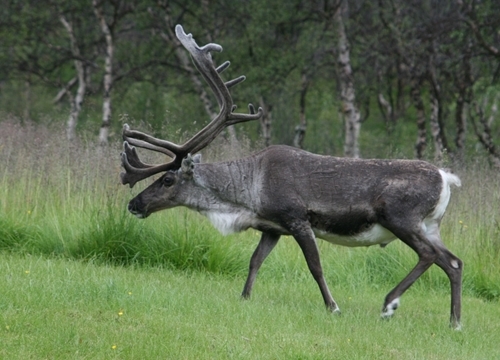
I have been thinking for some time what species I should chose for this month, but in the end, I thought I’d be cliché and pick a seasonal favourite – the reindeer Rangifer tarandus.
In 1821 the reindeer was first mentioned as an important species in the New York printer, William Gilley published a 16-page booklet titled A New Year’s Present to the Little Ones from Five to Twelve, Part III by an anonymous author:
Old Santeclaus with much delight
His reindeer drives this frosty night.
O'er chimneytops, and tracks of snow,
To bring his yearly gifts to you.
Two years later, in 1823, Clement Clark Moore’s poem “A Visit from St. Nicholas”, commonly known as ‘Twas the Night Before Christmas’, also mentioned reindeer as Santa’s sleigh pullers, and for the first time, they were identified by name. This poem is a firm family favourite of ours and has been read every year on Christmas Eve since I was born. It’s not without good reason that reindeer were chosen for this most important of roles, they were definitely the top candidate for the job and I will explain why…
Reindeer originally inhabited the tundra and forests of Scandinavia and northern Russia, and were then introduced into Iceland, Greenland, Alaska, and Canada. It is thought there about 3.5 million caribou in North America and perhaps one million wild reindeer in Eurasia, mostly in Russia and nearly three million domestic reindeer living in northern Europe.
Reindeer are also referred to as caribou, but they are the same animal (Rangifer tarandus) and are a member of the deer family (Cervidae). In Europe, they are called reindeer and have been domesticated. In North America, the animals are called caribou if they are wild and reindeer if they are domesticated. Reindeer are the only deer species to be widely domesticated.
Living in such regions, reindeer are adapted to the cold and are the only deer species to have hair all over their bodies (heavy hallow guard hairs to keep warm) from the bottom of their hooves to completely covering their nose! Colour varies from whitish in winter to brown in summer. Hairy hooves may look strange, but it gives reindeer a good grip when walking on frozen ground, ice, mud, or snow. Spongy footpads help them walk in marshy fields, and in winter, their hooves harden so they can dig into the ice or snow and keep from slipping.
With their feet providing good traction, no matter the weather, reindeer are able to run at speed and over distance. They can trot at 25 miles per hour, doubling their speed if they want to make a getaway from predators. They have also been recorded travelling 500 air miles in six weeks across varied terrain. With speed and stamina like that, reindeer make very reliable sleigh buddies!
Their specialised nose helps to warm incoming cold air before it enters their lungs. Their good sense of smell helps the reindeer find food hidden under snow, locate danger, and recognize direction. Reindeer mainly travel into the wind so they can pick up scents.
Size wise, large males can stand more than 1.2 metres (3.9 feet) tall at the shoulder and exceed 250kg (550 pounds) in weight; females are slightly smaller and survive on a diet of mosses, herbs, ferns, grasses, and the shoots and leaves of shrubs and trees, especially willow and birch. In winter, they make do with lichen (also called reindeer moss) and fungi, scraping the snow away with their hooves to get it. An average adult reindeer eats 9 to 18 pounds of vegetation a day.
There are two varieties, or ecotypes: tundra reindeer and forest (or woodland) reindeer. Tundra reindeer migrate between tundra and forest in huge herds numbering up to half a million in an annual cycle covering as much as 5,000 km (3,000 miles). Forest reindeer are much less numerous. The rut occurs in October and lasts only 11 days, but the male tundra reindeer cannot compete for females until their fourth autumn, when their antlers and body mass have grown sufficiently large. Tundra males, aggregated with thousands of females for the autumn migration, they assess other males’ antler size visually and thus generally avoid serious fights.
However, the forest reindeer on the other hand, defend discrete harems and fight harder. In both varieties a single calf is born in May or June after a gestation of seven and a half months. The calf grows rapidly on its mother’s milk, which is richer than that of any other ungulate. After one month it can eat fresh plant growth, and by three months it can survive if the mother dies, but normally weaning takes place at five to six months. Half of all calves born may be killed by wolves, bears, and lynx. Longevity is about 15 years in the wild, 20 in captivity.
Both male and female reindeer grow antlers - males start growing their antlers in February and drop them in November, leaving them without antlers until the following spring, while females start growing in May and keep their antlers through the winter until their calves are born in May. Compared to their body size, reindeer have the largest and heaviest antlers of all living deer species. A male’s antlers can be up to 51 inches long, and a female’s antlers can reach 20 inches.
With their adaptable hooves, speed and ability to avoid the effects of jet lag (they don’t release melatonin into their bloodstream, so they can respond to their own needs, without their bodies being influenced by the seasons), the reindeer are the perfect choice as a Christmas travel companion!
Perhaps you have learnt one or two new facts, but can you name the famous eight reindeer?
Merry Christmas!
Megan Lock
Advisory